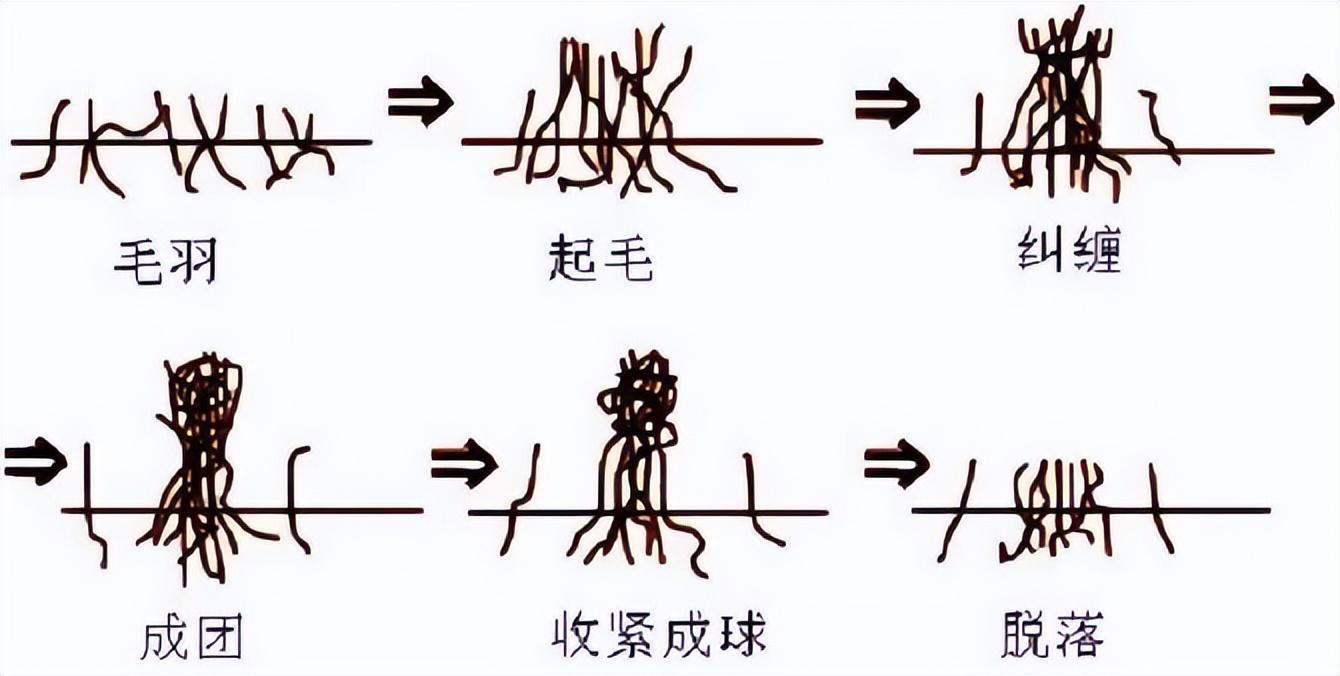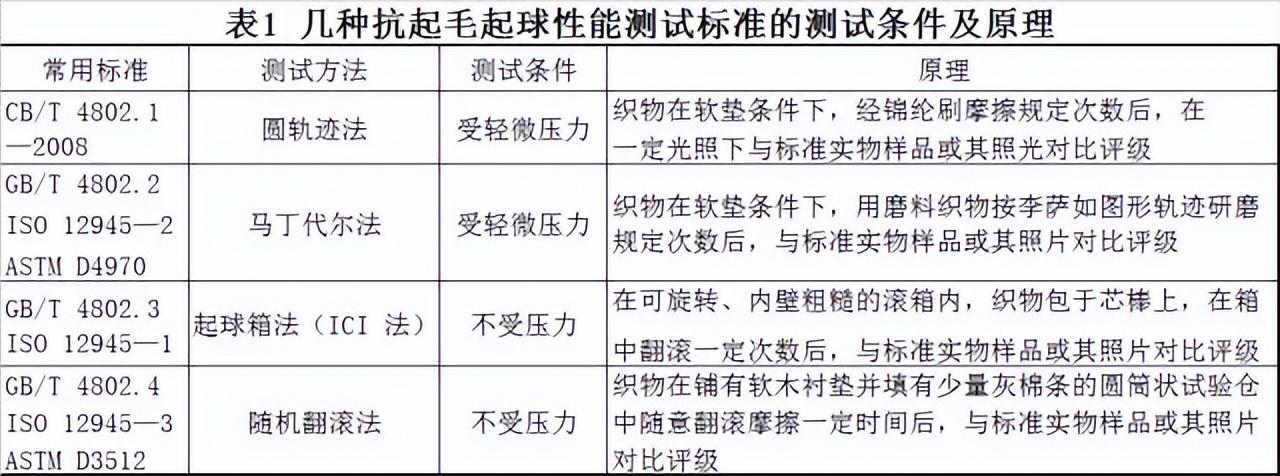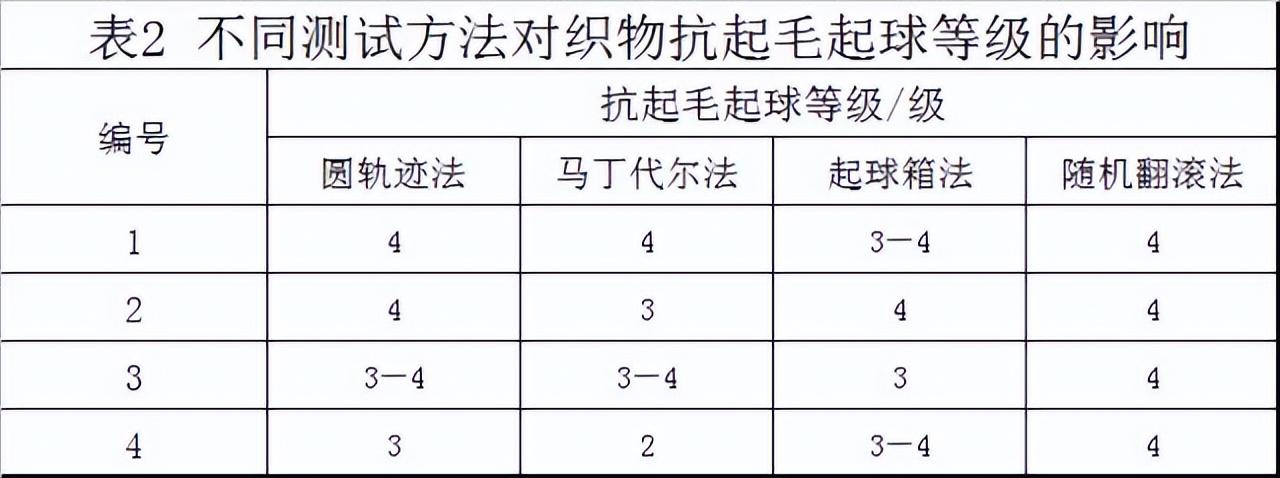With the continuous improvement of people’s living standards, the requirements for clothing are no longer limited to warmth and durability, but also put forward new requirements for comfort, aesthetics, functionality, etc. Fabrics are prone to pilling during wearing. This phenomenon not only worsens the appearance and feel of the fabric, but also causes wear and tear on the fabric and reduces the wearing performance of the fabric.
The process of fabric pilling

Fluffing:
Plush is initially produced along the longitudinal direction of the fiber. When the fabric is subjected to external friction, when the friction force is greater than the fiber strength or the friction between fibers or the cohesion force, the fiber ends will It is pulled out to form loops and fluff, and fluff is generated on the surface of the fabric, making the fabric lose its luster.
Entangled into Ball:
in Plush In dense areas, loose fibers become entangled. When the fluff is exposed to a certain length, the fluff at a certain distance will be tangled into a ball due to repeated elongation and retraction due to rubbing and friction. The generated hair ball is not large and does not form a dead knot. One end of it is embedded in the fiber of the fabric and connected to the cloth surface. Wool balls easily trap dirt and affect the appearance of the fabric.
Hair ball growth: strong>
The entangled fibers come together to form small Balls, these small balls are made of strong fibers hanging from the surface of the fabric and continue to grow.
hair ball falling off: strong>
As the fabric continues to be rubbed, The fibers connecting the wool balls will break due to repeated stretching and bending fatigue and fall off the cloth surface. People’s perception of whether fabrics are prone to pilling is often inconsistent with the actual situation. Fabrics that are prone to pilling often give people the impression that they are not prone to pilling due to the short life of the pom poms.
Factors affecting pilling
1. Fiber properties
Fiber strength
Fibers with high strength, long elongation, high resistance to repeated bending, and strong wear resistance, friction It is not easy to be worn off and fall off, but will cause it to further tangle with the surrounding hair clumps and hair balls to form larger balls. The fiber strength is low, and the hair balls formed are easy to fall off from the fabric surface after friction. Therefore, fibers with high strength are prone to pilling.
Fiber length
Short fibers are easier to pill than long fibers. Long fibers are less prone to pilling than short fibers. The friction resistance of long fibers in the yarn is greater than that of short fibers, and it is difficult to extract them from the yarn. Within the same number of fiber cross-sections, long fibers have fewer exposed yarn surface ends than short fibers, and are less likely to be rubbed by external forces. Polyester filament has high strength and is not easy to wear and break when subjected to mechanical external force. Polyester filament fabric is not easy to pilling.
Fiber fineness
For the same raw materials, fine fibers are thicker than Fibers are more prone to pilling. The thicker the fibers, the greater their bending stiffness. The fiber heads standing on the surface are less likely to bend, entangle and pill.
Interfiber friction
The friction between fibers is large; Not easy to slide and not easy to pill
Fiber blends are prone to pillingn>
Pilling increases gradually.
Pilling and tight fabric structure The size of the degree, the number of tissue intersections and the smoothness of the cloth surface are all related.
Knitted fabrics are prone to pilling compared to woven fabrics
Weft-knitted fabric is relatively Warp knitted fabrics are prone to pilling
Coarse gauge fabrics are easier to pill than fine gauge fabrics
Ribbed fabrics are easier to pill than plain fabrics
Low gauge fabrics are more prone to pilling than high gauge fabrics
Lightweight fabrics are more prone to pilling than heavy fabrics
For the same type of fabric, the tighter the tissue structure, the less likely it is to fluff. Ball
4. Dye The impact of the whole process
Finishing is closely related to fabric pilling. After yarn or fabric is dyed and finished, the anti-pilling properties will change greatly. This is related to dyes, auxiliaries, dyeing and finishing processes. Conditions related.
Dye and dyeing process affect fiber strength and fiber The friction between them affects the pilling performance.
The purpose of softening is to improve the feel of the fabric and elasticity. During the softening process, too much softener will reduce the friction between fibers or yarns, making it easier for fibers to slip and pull out, and the anti-pilling performance of the fabric will decrease to a certain extent.
The refining process requires oil removal and cleanliness. Otherwise, the oil will easily absorb small particles and lint during wearing and washing, which will affect the anti-pilling effect. The residual oil will reduce the friction of the fibers and cause the fibers to move outward, causing pilling.
Reasonable optimization of finishing process parameters: including temperature , finishing agent dosage, finishing time.
Filling and Pilling Test Method
Currently, commonly used anti-pilling and pilling test methods include the circular trajectory method, Martindale method, pilling box method and random tumbling method.

Testing methods used by different standards Different, such as: national standard GB/T
4802.1-2008 “Determination of Pilling Properties of Textile Fabrics Part 1: Circular Trajectory Method”, National Standard GB/T
4802.2 “Martindale Method for Determination of Pilling Properties of Textile Fabrics”, National Standard GB/T 4802.3 “Determination of Pilling Properties of Textile Fabrics Pilling Box Method”, National Standard GB/T
4802.4 “Determination of Pilling Properties of Textile Fabrics by Random Tumbling Method”, International Standard ISO 12945-1 “Determination of Pilling Properties of Textile Fabrics by Pilling Box Method”, International Standard ISO
12945-2 “Determination of pilling properties of textile fabrics by Martindale method”, international standard ISO
12945-3 “Determination of pilling properties of textile fabrics by random tumbling method”, American Society for Materials Standard ASTM
D3512 “Determination of Pilling Properties of Textile Fabrics by Random Tumbling Method”, American Society for Materials Standard ASTM
D4970 “Determination of Pilling Properties of Textile Fabrics by Martindale Method”. The test principles and test conditions of different methods used in the above standards are shown in Table 1.

Due to test methods, conditions, and principles Different fabrics have different anti-pilling properties. The effects of different testing methods on the pilling resistance level of fabrics are shown in Table 2.

As can be seen from Table 2, due to the test Different methods lead to differences in test results. For textile export enterprises, faced with different standards of trading countries, when testing anti-pilling, they should choose the corresponding test method according to the use of the product and customer requirements. Customers have increasingly higher requirements for fabrics. Testers should learn from many foreign testing standards, pay attention to the testing standards required by the target, market, and exporting country in the trade contract, and conduct testing and rating strictly in accordance with their requirements to avoid failure due to lack of understanding of the standards. Impact on production and sales, resulting in losses to customers and the company.
Fabrics that are prone to pilling
Wool and its blended fabrics:
Knitted sweaters, woolens, cardigans, etc.
Chemical staple fibers and their blends Fabric:
Polycotton, Polyester viscose, nitrile cotton, etc.
Knitted light fabrics:
Pure cotton rack, Modal , viscose, lyocell and other regenerated cellulose fiber fabrics.
Denim embroidery
k=”105″ style=”text-align: left;”>Due to different testing methods, conditions, and principles, the anti-pilling performance of the same piece of fabric will vary greatly difference. The effects of different testing methods on the pilling resistance level of fabrics are shown in Table 2.

As can be seen from Table 2, due to the test Different methods lead to differences in test results. For textile export enterprises, faced with different standards of trading countries, when testing anti-pilling, they should choose the corresponding test method according to the use of the product and customer requirements. Customers have increasingly higher requirements for fabrics. Testers should learn from many foreign testing standards, pay attention to the testing standards required by the target, market, and exporting country in the trade contract, and conduct testing and rating strictly in accordance with their requirements to avoid failure due to lack of understanding of the standards. Impact on production and sales, resulting in losses to customers and the company.
Fabrics that are prone to pilling
Wool and its blended fabrics:
Knitted sweaters, woolens, cardigans, etc.
Chemical staple fibers and their blends Fabric:
Polycotton, Polyester viscose, nitrile cotton, etc.
Knitted light fabrics:
Pure cotton rack, Modal , viscose, lyocell and other regenerated cellulose fiber fabrics.
Denim embroidery






